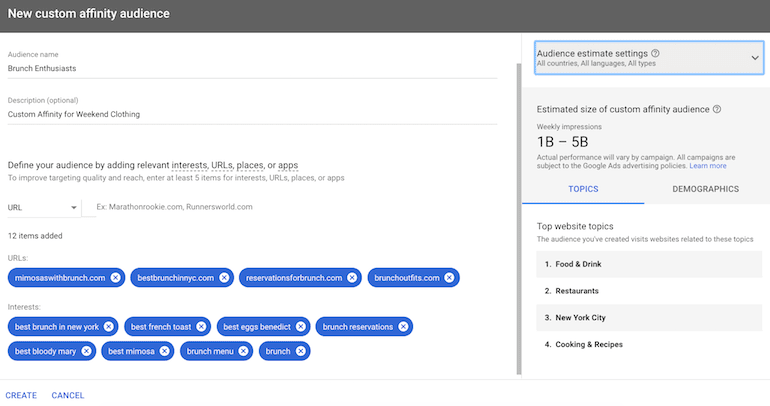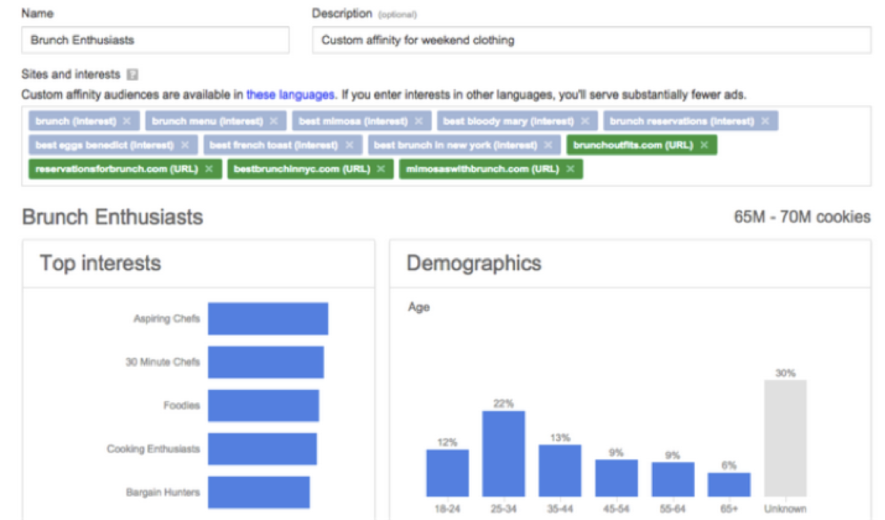Below we dig into 3 killer strategies for using custom affinity audience targeting, performance results and key lessons learned from managing custom affinity targeting.
Affinity audience targeting is not new. Facebook, Google, and Amazon have been using them for some time and have seen huge success. Affinity Audiences are TV-style audiences that are designed to help connect advertisers with their ideal customers online at scale. Google Ads uses a users browsing history, time on pages visited and then associates an interest category with the users browser. The problem with affinity audiences is that they can be broad and match to some random targets.
Where custom affinity shows value is the ability to have more control over the affinity categories (and we know PPC managers love control and transparency). With custom affinity audiences you determine your target affinity audience based on specific URLs and categories on the Google Display Network.
What is Custom Affinity Audience Targeting?
Google defines custom affinity audiences as letting advertisers define whom they want to reach across the web, on any screen. By factoring in consumers’ most recent passions and ongoing interests, your message always reaches the right users.
Custom affinity audience targeting can be set-up by following this path.
Tools and Settings > Audience Manager > Custom Audiences > Custom Affinity

Once selected, create your own specific audience. You can add custom affinity audiences combining of:
- Interests entered as keyword phrases
- Using URLs as a proxy for interest bundles
- Types of places people are interested in
- Apps the ideal customer may be interested in
When To Use Custom Affinity Audience Targeting
Do any of the initiatives below describe your efforts?
- Branding
- More controlled targeting on GDN or YouTube
- Advertise tailored real-time content to specific users
- Increase market reach while driving incremental conversions
If you answered yes to any of the items above then custom affinity audience targeting could be right for your account. Custom affinity campaigns can be used for any vertical looking to expand reach on YouTube or the Google Display Network while targeting a very specific audience. These types of campaigns also tend to work well as a form of branding or top-of-funnel expansion.
Strategies and Results
Now that you have an idea of what custom affinity audience targeting is and how it works, below are a few ideas for ways to create a strategy for implementation.
1. Top Performing Placements
We tested this strategy for one ecommerce client that was focusing on driving incremental conversions within the Google Display Network. First, we identified the top 10 performing placements and used those as the basis for the custom affinity audience. While we did see a small lift in conversions, the CPA was almost 50% higher compared to contextual keyword targeting campaigns. By layering the custom affinity audience campaign with contextual keywords and running regular placement exclusions, we have started to see CPA come back down.

2. Competitor Targeting
For this account, the advertiser was competing in a lead generation space with heavy competition against businesses with deep pockets spent on branding. With tight CPL targets, the advertiser was looking to gain incremental conversions and brand awareness efficiently on the Google Display Network. To accomplish this goal we created an audience targeting the top 5 competitors in the space. We were pleasantly surprised at the results, which resulted in a 4% lift in leads at a CPL 30% less than the contextual keyword targeted campaign.
While we saw great results using this strategy, the campaign was regularly reaching the set budget caps. When running these types of campaigns be prepared to spend the set budget. To help increase efficiency, try potentially layering custom affinity audience targeting with other display targeting options such as contextual keywords to refine the custom audience size and avoid being capped by budget.

3. Interest + Custom Affinity Targeting
Google provides several examples of advertisers that used interest based targeting layered with custom affinity audiences to reach a specific user and saw strong results.
In the example below the custom affinity targeting created an audience of “Brunch Enthusiast” using interest and custom affinity targeting. Google reported that several advertisers using this real-time approach yielded great results.

Key Learning
While custom affinity audience targeting allows for more control on YouTube or the GDN, I found that it performed best as a branding tool that offers a creative way to reach new users and drive incremental conversions. To get the best results with these campaigns make sure to:
- Do your research when selecting your custom audience placements
- Use creative ad copy based on the target audience
- Regularly audit your placements
- Don’t be afraid to layer the campaigns with other forms of targeting to increase efficiency as we have found these campaigns like to spend their budgets
For more in-depth information on audience targeting read the free whitepaper, Unforgettable Tips to Optimize Audience Targeting.




